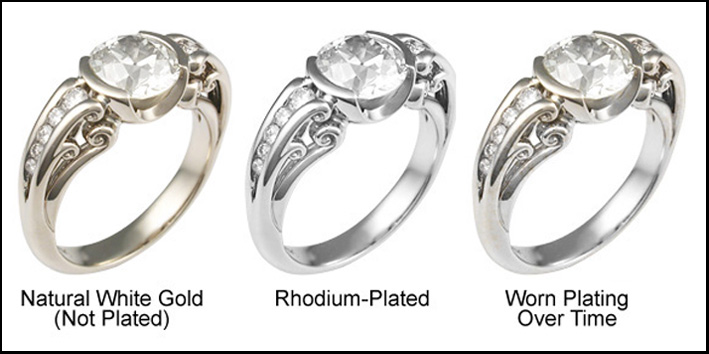Precious Metals
Breakdown of the Precious metals used in modern engagement rings
Gold
Gold is the most commonly used precious metal used in the jewelry industry. Gold has been consistently used in the making of jewelry since ancient times and is revered for its luster, rich color and malleability (allowing it to be shaped into fantastic designs). Despite Gold's prominent use in the jewelry industry, it has been estimated that all the Gold ever mined would fill roughly 3.5 Olympic-sized swimming pools. Pure gold (denoted by 24k) is so soft and malleable that one ounce of Gold could be hammered into a sheet nearly 10ftx10ft or stretched into a wire nearly 50 miles long. Due to its softness, Gold in it's 24k state isn't often used in jewelry and almost never used for jewelry with stones. Gold is often alloyed with other metals to enhance it's strength (most frequently copper, nickel or palladium) and the alloy frequently depends on the desired color of Gold. The karat of gold refers to it's purity: 14k means it is 14 parts Gold out of 24 with 10 parts alloy, 18k means it is 18 parts Gold/6 parks alloy. Some jewelers denote jewelry with the percentage of the purity of the Gold: 14k=585 (58.5% Gold), 18k=750 (75% Gold). 10k is the lowest alloy to be called Gold legally in the United States (however, lower karat levels can be found abroad). The most frequently used alloys in the United States are 14k or 18k for fine jewelry. White Gold is plated with Rhodium (a member of the Platinum family, along with Platinum, Palladium, Iridium, Osmium, and Ruthenium, that is extremely rare and has some of the brightest luster of the known precious metals). The Rhodium plating will wear away over time with everyday wear and tear and will have to be Rhodium plated regularly (the average is once each year or every other year depending on the person wearing it, it is not recommended to Rhodium plate more frequently than once a year if it can be avoided) to maintain its white color and luster. Despite the alloy, Gold is still a softer metal making it prone to scratching and regular polishing will slowly wear the metal down (again, it is not recommended to polish gold more than once per year if it can be avoided). However, Gold can be sized, refurbished, repaired and maintained better than most metals currently on the market.

Platinum
Platinum is aw naturally white metal that is second only to gold for its use in fine jewelry. Due to its naturally white state, it is considered to be the best white metal to be used in jewelry. Platinum is three times rarer than Gold and is therefore more expensive; however, due to its 90-100% purity level ad its higher density, you receive more precious metal per ounce than with Gold. Platinum can be notated in several different ways: Plat or PT, or combined with the percentage of it's purity 900Plat/PT, 950Plat/PT, or 995 Plat/PT (90.0%, 95.0% or 99.5% respectively). Platinum, being one of the purest metals, is hypoallergenic. Its density also makes Platinum a significantly longer lasting metal than other precious metals and more ideal for stone setting and security due to it's lower metal memory. Metal memory is the tendency of a metal to snap back to the state it was in at the time of casting (meaning prongs are more likely to gradually pull back off a stone). Without metal memory, it is less likely to knock prongs away from, or break prongs away from stones. When Platinum is scratched, instead of removing small amounts of metal, it displaces the metal allowing it to be reshaped and polished, giving it a longevity of up to 10x longer than other precious metals.
Breakdown of other precious metals
Palladium
Palladium is a member of the Platinum family that is naturally white but lighter weight than Platinum. Palladium rose to prominence in the jewelry market as a cost efficient alternative to Platinum being only slightly more expensive than Gold. Palladium feels similar to gold in weight and is similar in scratch resistance. Palladium is more reactive than Platinum or Gold (especially to chlorine) and therefore be worn with care (and should never be worn while swimming). Similar to Platinum, Palladium is considered hypoallergenic due to its purity, which is also 90%, 95% or 100% pure. Palladium is marked in rings with the stamp PD.
Sterling Silver
Sterling Silver is an alloy comprised of 92.5% pure (fine) Silver and 7.5% Copper, Nickel and Zinc. Fine Silver is incredibly soft and malleable and is therefore alloyed to increase strength. Sterling Silver is naturally white and considered to be the precious metal with the brightest white luster. Silver is the only precious metal that tarnishes. Tarnish is the dark layer that builds up on Silver as it reacts to the trace amounts of Hydrogen Sulfide in the air. Tarnish is easy to remove and can usually be removed with treated polishing cloths, however, tarnish builds up slower on jewelry with regular wear (natural body oils and the friction of regular skin contact helps remove tarnish as it builds up). Sterling Silver, due to a lack of plating and alloy of Nickel, has the highest rate of allergic reaction. Sterling Silver is marked in jewelry as 925.
